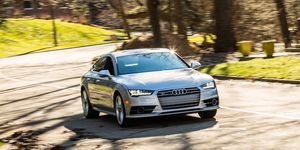Less is more, or so they say. But they are not us. After sitting out a season, the inconspicuous Audi S7 returns to the roster rendered in sharper sheetmetal, overflowing with tech, and sporting two fewer cylinders. We take issue with that last bit. Listen, we like V-8s and the music their pistons mosh to. When we first learned of the downsized engine, it seemed like Audi was trying to convince us we’d really enjoy a Hall & Oates concert instead of the Rage Against the Machine banger we’d come to expect. No, thanks.
The new twin-turbocharged and supercharged 2.9-liter V-6 replaces the fiery growl of the old twin-turbo 4.0-liter with a far less dramatic sound. Its 444-hp rating is down six from the former V-8’s, but peak torque swells by 37 lb-ft to 443. A 48-volt motor-generator smooths auto stop-start operation, while Audi’s 48-volt electric supercharger rouses low-rpm throttle response. The electric compressor—the Audi S6 and S7 are the first models in the United States to feature the tech—is plumbed between the two turbos and the single air-to-liquid intercooler. The goal is to eliminate lag, a fundamental byproduct of turbocharging. The little electric supercharger idles at 5000 rpm and can quickly spin up to 70,000 rpm, generating meaningful boost while the turbos are getting warmed up to their maximum 21.5 psi of pressure. Once the turbos are up to speed, the liquid-cooled supercharger returns to idle.
The electric components don’t increase peak horsepower, but they do add to the overall weight. Audi claims the electric supercharger system weighs 22 pounds itself. Tipping the scales at 4640 pounds, the new S7 outbeefs its predecessor by 132 pounds. The eight-speed automatic’s shifts aren’t as snappy as the competition’s, nor are they as crisp as those made by the seven-speed dual-clutch automatic it replaces, and it shows. The S7 runs a 4.1-second 60-mph dash and the quarter-mile in 12.5 seconds, 0.3 and 0.2 second slower, respectively, than the old car. The Porsche Panamera 4S—a platform cousin of the S7—powered by the same 2.9-liter sans the electrical bits will easily run past the S7. Equipped with Porsche’s magnificent dual-clutch eight-speed, the Panamera’s transmission has a very aggressive launch control that allows for a 4900-rpm clutch dump. Launch control, plus weighing 155 pounds less helps the Panamera 4S rocket to 60 mph in just 3.5 secondswith the quarter-mile flickering by in 12.0 seconds. The S7’s conventional torque-converter eight-speed only revs up to around 3000 when launch control is active.
Though some personality and acceleration are lost, the gleeful driving dynamics remain. The ride quality on the optional coil springs—part of a $4350 S Sport ensemble—is on the firmer side of the spectrum, and our car’s $1000 21-inch wheels don’t wear enough sidewall to suppress sharp impacts. Easier-riding air springs and 20-inchers are standard. The portly S7 is eager to hustle, though. The four-wheel steering coupled with the torque-vectoring rear differential of the S Sport package makes the S7 feel like a rear-drive car even though all four wheels are driven. Strong and massive two-piece 15.7-inch front rotors clamped by six-piston calipers erase speed with sports-car-like security. From 70 mph, the S7 stops in a short 151 feet.
Inside, the S7 is treated to a wholesale refresh. Like the Audi A7 that debuted last year, the S7’s interior has a more modern feel and premium materials that stretch to all corners. The S7 is now packed full of cleanly rendered digital displays, including a 12.3-inch digital gauge cluster. The haptic controls and the menus of the infotainment and HVAC screen take a little getting used to, but with a little familiarity, the functions become intuitive. Despite having dual-pane side glass in front, a whisper of wind rush penetrates the cabin at highway speeds, but it isn’t enough to spoil the serenity of the cockpit.
The downsized powertrain does offer one big benefit: efficiency. The EPA says the new S7 will return 22 mpg in combined driving, 4 mpg better than the previous one. That must require some tippy-toe throttle applications because during 250 miles of normal driving we managed just 16 mpg. However, during our 75-mph highway fuel-economy test we averaged 28 mpg, matching the EPAs rating. Oh, and Audi hasn’t killed the V-8-powered luxo-hatch. The 591-hp RS7 just requires an additional $30K.
Source: Reviews - aranddriver.com





